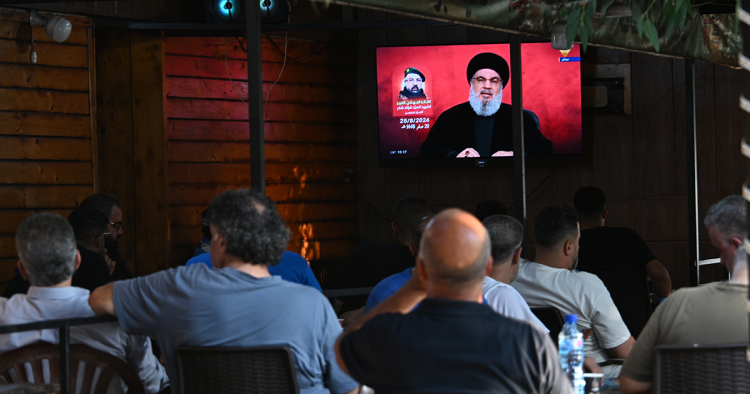On Aug. 25, Hezbollah retaliated for Israel’s assassination of senior commander Fuad Shukr on July 30, launching 340 rockets and tens of drones from southern Lebanon and the eastern Beka’a region. According to Hezbollah Secretary-General Hassan Nasrallah, this was the first time its drones were launched into Israel from the Beka’a. Hezbollah’s retaliation started shortly after Israel undertook what it called a “preemptive strike,” in which 100 fighter jets targeted Hezbollah military sites, including rocket launching platforms, to thwart a larger attack that, according to Israeli officials, involved up to 6,000 rockets.
In the aftermath, both sides engaged in a war of narratives, each trying to frame their respective operation as a success. Israel’s success criterion was to thwart a larger Hezbollah attack. Nasrallah’s success criterion was that despite Israel’s pre-emptive strike, Hezbollah managed to carry out its own “limited” planned attack. It is not clear whether any of Hezbollah’s rockets and drones reached their targets; Israel maintains a media blackout and Nasrallah said Hezbollah needed time to find out.
In his post-retaliation speech on Aug. 25, Nasrallah offered four reasons for Hezbollah’s delayed response:
-
It needed time to identify targets;
-
It wanted to increase and prolong anxiety in Israel in anticipation of its response;
-
The Iran-led Axis of Resistance needed time to decided how to respond to the assassinations of Shukr and Hamas political leader Ismail Haniyeh as well as the Israeli attack on the Houthi-controlled port of Hodeida in Yemen. In particular, they deliberated on whether the response should be collective or whether each party should choose the form and timing of its response individually. He said they decided on the latter; and
-
Hezbollah wanted to give time and space for the ongoing Gaza cease-fire negotiations. He reiterated that a cease-fire deal remains its priority. Since Hezbollah has concluded that the negotiations are not going anywhere, Nasrallah said there was no reason to delay its response any longer.
Where do we go from here? Given the continuing failure of the Hamas-Israel negotiations in Doha and Cairo, the war started by Hezbollah on Oct. 8 in support of Hamas and the Palestinians is here to stay. Hezbollah is in a strategic trap of its own making. By linking the cessation of its war to a Gaza cease-fire deal, it has relegated the decision over when to end it primarily to the Israeli prime minister, who does not seem to be in any hurry.
As the conflict drags on without a clear roadmap of when and how it will end, Hezbollah’s war of support is facing diminishing returns. More than 400 of its commanders, including fairly senior cadres, have been assassinated. Swathes of Lebanon’s southern villages, long believed to be a Hezbollah stronghold, have been destroyed and their farmlands burned. More than 100,000 Lebanese, most of whom are Hezbollah constituents, have been displaced from their homes. Add to that the nearly 150,000 Lebanese civilians who still live within 10 km of the Blue Line and are caught in the daily crossfire between Hezbollah and Israel.
Outside of Hezbollah’s core constituency, the fairly strong backing for its war of support inside Lebanon is rapidly declining. It is no coincidence that in his Aug. 25 speech, Nasrallah sought to reassure listeners that a larger war is not happening and that people can go back to their normal lives.
The conflict dynamics on the Lebanese-Israeli front are thus back to where they were pre-July 30, before Shukr’s killing, with the daily exchange of cross-border fire and an ongoing Israeli assassination campaign targeting Hezbollah, Hamas, and lately Fatah commanders in Lebanon. For their part, Iran and the Houthis say they will carry out their own responses to the Haniyeh assassination and the Hodeida attack.
In his Aug. 25 speech, Nasrallah explained Hezbollah’s target selection criteria in detail, partly in an effort to establish rules of engagement with Israel. Whether Israel will heed them is yet to be seen. He spoke of three rules: No targeting of civilians, no targeting of infrastructure, and targeting of an Israeli military installation that was involved in the planning and execution of Shukr’s assassination. The latter is akin to Israel’s argument that Shukr was killed because he was responsible for the planning and execution of the July 27 Hezbollah attack on Majdal Shams in the Israeli-occupied Golan Heights. The Hezbollah retaliation playbook is eerily similar to the one Iran followed last April when it attacked Israel in response to the latter’s strike on its consulate in Damascus.
To date, neither Hezbollah nor Israel, nor their backers Iran and the US, wants an all-out war. Israeli Prime Minister Benjamin Netanyahu’s Aug. 25 statement that this latest episode is “not the end of the story,” coupled with the growing chorus of Israeli politicians and security figures calling for Israel to change the situation in the north and the fairly high levels of public support for military action against Hezbollah, might end up pushing Netanyahu, who has been reluctant to do so until now, into launching a large war on Lebanon. If past is prologue, such a move would likely end badly: Israel’s wars on Lebanon in 1982 and 2006 were the death knell for his predecessors’ careers.
Randa Slim is the Director of the Conflict Resolution and Track II Dialogues Program at the Middle East Institute and a non-resident fellow at the Johns Hopkins University School of Advanced and International Studies (SAIS) Foreign Policy Institute.
Photo by Houssam Shbaro/Anadolu via Getty Images
The Middle East Institute (MEI) is an independent, non-partisan, non-for-profit, educational organization. It does not engage in advocacy and its scholars’ opinions are their own. MEI welcomes financial donations, but retains sole editorial control over its work and its publications reflect only the authors’ views. For a listing of MEI donors, please click here.













